
Carex is a vast genus of nearly 2,000 species of grass-like plants in the family Cyperaceae, commonly known as sedges. Other members of the family Cyperaceae are also called sedges, however those of genus Carex may be called true sedges, and it is the most species-rich genus in the family. The study of Carex is known as caricology.

Carex cespitosa is a species of perennial sedge of the genus Carex which can be found growing in tufts (caespitose), as the Latin specific epithet cespitosa suggests. The name is synonymous with Carex cespitosa f. retorta.

Carex flacca, with common names blue sedge, gray carex, glaucous sedge, or carnation-grass,, is a species of sedge native to parts of Europe and North Africa. It is frequent in a range of habitats, including grasslands, moorlands, exposed and disturbed soil, and the upper edges of salt marshes. It has naturalized in eastern North America.

Kingdown and Middledown is a 5.7 hectare biological Site of Special Scientific Interest near Cheddar in the Mendip Hills, Somerset, notified in 1991.
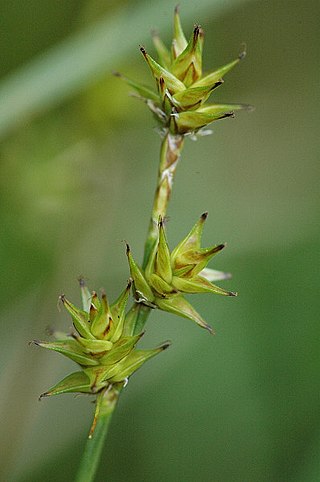
Carex echinata is a species of sedge known by the common names star sedge and little prickly sedge.

Carex limosa is a species of sedge known as bog-sedge, mud sedge, and shore sedge.

Carex comosa is a species of sedge known as longhair sedge and bristly sedge. It is native to North America, where it grows in western and eastern regions of Canada and the United States, and parts of Mexico. It grows in wet places, including meadows and many types of wetlands. Tolerates deeper water than most common species and is good for retention basins. This sedge produces clumps of triangular stems up to 100 or 120 centimeters tall from short rhizomes. The inflorescence is up to 35 centimeters long and has a long bract which is longer than the spikes. It is a cluster of several cylindrical spikes. The scales over the fruits taper into long, thin awns.
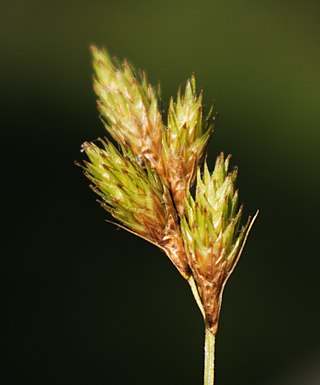
Carex scoparia is a species of sedge known by the common names broom sedge and pointed broom sedge. It should not be confused with the unrelated grass species known as "broom sedge," Andropogon virginicus.

Carex disticha is a Eurasian species of sedge known as the brown sedge or, in North America, tworank sedge.

Carex acutiformis, the lesser pond-sedge, is a species of sedge.
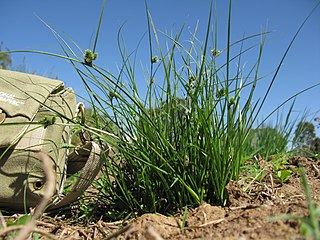
Carex inversa, commonly known as knob sedge, is a species of sedge of the family Cyperaceae that is native to parts of Australia and New Zealand and has also been introduced into Great Britain.

Carex flava, called hedgehog grass, is a widespread species of sedge, native to the northern United States, Canada, Iceland, Europe, the Atlas Mountains in Africa, the Transcaucasus area, and parts of Siberia. It is the namesake of the Carex flava species complex.
Carex hyalinolepis is a tussock-forming species of perennial sedge in the family Cyperaceae. It is native to southern parts of North America from Ontario in the north to Texas in the south.
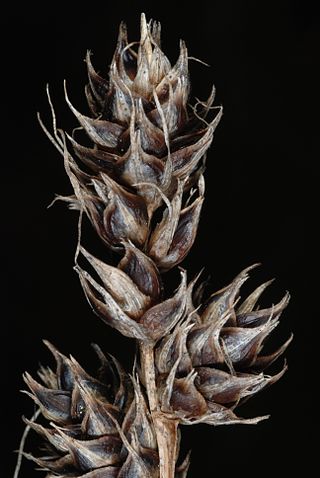
Carex gravida, also known as heavy-fruited sedge, heavy sedge or long-awned bracted sedge, is a tussock-forming species of perennial sedge in the family Cyperaceae. It is native to southern parts of Canada and parts of the United States.

Carex michauxiana, also known as Michaux's sedge, carex de Michaux or yellowish sedge in Canada, is a tussock-forming species of perennial sedge in the family Cyperaceae. It is native to eastern parts of North America and parts of Asia.

Carex digitalis is a tussock-forming species of perennial sedge in the family Cyperaceae. It is native to south eastern parts of Canada as well as central and eastern parts of the United States.
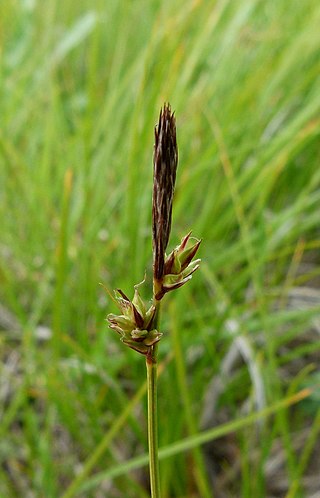
Carex lucorum is a tussock-forming species of perennial sedge in the family Cyperaceae. It is native to eastern parts of Canada and north eastern parts of the United States.

Carex vestita, also commonly known as velvet sedge, is a tussock-forming species of perennial sedge in the family Cyperaceae. It is native to eastern parts of the United States.

Carex curvicollis is a tussock-forming species of perennial sedge in the family Cyperaceae. It is native to parts of Japan.

















